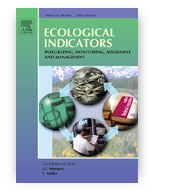
Research papers of the month – November 2023
We present the highest-score research papers of November 2023. These papers have ben published in journals with the highest Ministerial score – 200 points.
Assessment of heavy metal contamination of agricultural soils in Poland using contamination indicators
Paweł Tomczyk; Aleksandra Wdowczyk; Barbara Wiatkowska; Agata Szymańska-Pulikowska
Ecological Indicators
Ministerial score = 200.0
Journal Impact Factor (2023) = 6.9 (Q1)
 Heavy metals are considered a major pollutant due to their resistance to biodegradation, toxic effects on organisms, the fact that they can persist for long periods of time in soils and translocation. So far, no comprehensive, retrospective analyses have been carried out in Poland to assess spatial and temporal changes in contamination of agricultural soils with heavy metals (Cr, Cd, Cu, Ni, Pb, Zn, Co, V) using toxicity indices. The main objectives of the present study were to comprehensively assess the status of contamination of agricultural soils in Poland with selected heavy metals based on several indicators: Geoaccumulation Index (Igeo), Contamination Factor (CF), Potential Ecological Risk Index (ER), Enrichment Factor (EF), Pollution Index (PI) and Nemerow Pollution Index (NPI). Multivariate statistical analysis was also carried out, including principal component analysis (PCA) and descriptive statistics presented in box plots. Analyses were conducted over a period of 25 years at 216 study points within the framework of the chemistry monitoring of Poland's arable soils. This study will provide considerable assistance in the different soil types of Poland on the basis of toxicity indices. The presented research results show the spatial and structural diversification of soil contamination with metals and can be used in practice to formulate recommendations for rational soil use and planning investment activities in the field of environmental protection. In addition, these studies may be useful in the development of planning documents, especially in the development of postindustrial areas. At the analysed points, the potential toxicity of soils in relation to heavy metals was influenced by industrial activities in southern Poland (Upper Silesia) and south-western Poland (Lower Silesia); however, these exceedances affected few points (usually 2–3 of the 216 assessed). This situation persisted at these sites throughout the study period. The dominant type of contaminated soils was cambisols and phaeozems.
Heavy metals are considered a major pollutant due to their resistance to biodegradation, toxic effects on organisms, the fact that they can persist for long periods of time in soils and translocation. So far, no comprehensive, retrospective analyses have been carried out in Poland to assess spatial and temporal changes in contamination of agricultural soils with heavy metals (Cr, Cd, Cu, Ni, Pb, Zn, Co, V) using toxicity indices. The main objectives of the present study were to comprehensively assess the status of contamination of agricultural soils in Poland with selected heavy metals based on several indicators: Geoaccumulation Index (Igeo), Contamination Factor (CF), Potential Ecological Risk Index (ER), Enrichment Factor (EF), Pollution Index (PI) and Nemerow Pollution Index (NPI). Multivariate statistical analysis was also carried out, including principal component analysis (PCA) and descriptive statistics presented in box plots. Analyses were conducted over a period of 25 years at 216 study points within the framework of the chemistry monitoring of Poland's arable soils. This study will provide considerable assistance in the different soil types of Poland on the basis of toxicity indices. The presented research results show the spatial and structural diversification of soil contamination with metals and can be used in practice to formulate recommendations for rational soil use and planning investment activities in the field of environmental protection. In addition, these studies may be useful in the development of planning documents, especially in the development of postindustrial areas. At the analysed points, the potential toxicity of soils in relation to heavy metals was influenced by industrial activities in southern Poland (Upper Silesia) and south-western Poland (Lower Silesia); however, these exceedances affected few points (usually 2–3 of the 216 assessed). This situation persisted at these sites throughout the study period. The dominant type of contaminated soils was cambisols and phaeozems.
DOI:10.1016/j.ecolind.2023.111161
Salmonella adhesion is decreased by hypoxia due to adhesion and motility structure crosstalk
Krzysztof Grzymajło; Agata Dutkiewicz; Joanna Czajkowska; Ewa Carolak; Adrianna Aleksandrowicz; Wiktoria Waszczuk
Veterinary Research
Ministerial score = 200.0
Journal Impact Factor (2023) = 4.4 (Q1)
 Initial stages of Salmonella Typhimurium infection involve a series of coordinated events aimed at reaching, attaching to, and invading host cells. Virulence factors such as flagella, fimbriae, and secretion systems play crucial roles in these events and are regulated in response to the host environment. The first point of contact between the pathogen and host is the intestinal epithelial layer, which normally serves as a barrier against invading pathogens, but can also be an entry site for pathogens. The integrity of this barrier can be modulated by the hypoxic environment of the intestines, created by the presence of trillions of microbes. Variable oxygen concentrations can strongly affect many functions of the gut, including secretion of cytokines and growth factors from the host site and affect the ability of Salmonella to persist, invade, and replicate. In this study, we investigated the first stages of Salmonella Typhimurium infection under hypoxic conditions in vitro and found that low oxygen levels significantly decreased bacterial adhesion. Using adhesion and motility assays, biofilm formation tests, as well as gene expression and cytokine secretion analysis, we identified a hypoxia-specific cross-talk between the expression of type 1 fimbriae and flagella, suggesting that altered flagellin expression levels affect the motility of bacteria and further impact their adhesion level, biofilm formation ability, and innate immune response. Overall, understanding how Salmonella interacts with its variable host environment provides insights into the virulence mechanisms of the bacterium and information regarding strategies for preventing or treating infections. Further research is required to fully understand the complex interplay between Salmonella and its host environment.
Initial stages of Salmonella Typhimurium infection involve a series of coordinated events aimed at reaching, attaching to, and invading host cells. Virulence factors such as flagella, fimbriae, and secretion systems play crucial roles in these events and are regulated in response to the host environment. The first point of contact between the pathogen and host is the intestinal epithelial layer, which normally serves as a barrier against invading pathogens, but can also be an entry site for pathogens. The integrity of this barrier can be modulated by the hypoxic environment of the intestines, created by the presence of trillions of microbes. Variable oxygen concentrations can strongly affect many functions of the gut, including secretion of cytokines and growth factors from the host site and affect the ability of Salmonella to persist, invade, and replicate. In this study, we investigated the first stages of Salmonella Typhimurium infection under hypoxic conditions in vitro and found that low oxygen levels significantly decreased bacterial adhesion. Using adhesion and motility assays, biofilm formation tests, as well as gene expression and cytokine secretion analysis, we identified a hypoxia-specific cross-talk between the expression of type 1 fimbriae and flagella, suggesting that altered flagellin expression levels affect the motility of bacteria and further impact their adhesion level, biofilm formation ability, and innate immune response. Overall, understanding how Salmonella interacts with its variable host environment provides insights into the virulence mechanisms of the bacterium and information regarding strategies for preventing or treating infections. Further research is required to fully understand the complex interplay between Salmonella and its host environment.
DOI:10.1186/s13567-023-01233-2










